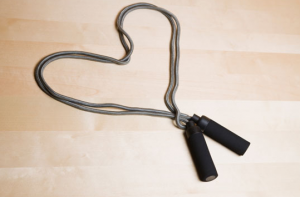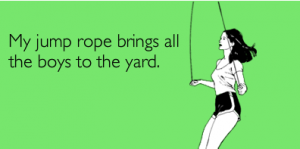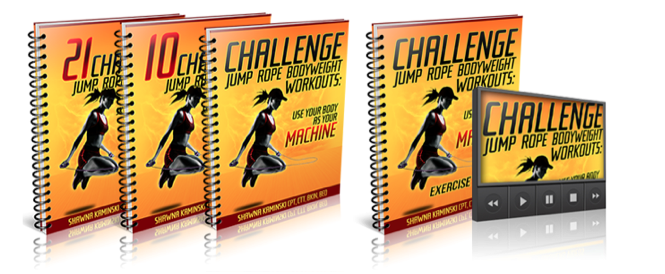Jumping rope is an excellent way to burn fat IF you know how to skip. If you don’t, it can be frustrating and the only thing that gets a workout is your patience. Like anything, jumping rope takes practice and it’s not quite as easy as it looks. It’s such an elementary move, often people are reluctant to do it because ‘everyone should already know how to skip already’ right?
Not so.
I’ll tell you that I had a hoot teaching grade school when it came to jump rope. It seemed that the boys had a harder time with this skill. This has nothing to do with gender and everything to do with practice. It was generally more acceptable for girls to be skipping at recess time while boys gravitated towards games that involved a ball.
Once I made jumping rope cool, boys were willing to give it a go. I don’t know how I did it, but I was able to make most things fun and cool when I was a teacher. I could pretty much get kids to do anything for me. I’m pretty sure it was because they could tell that I really loved them and I loved what I was doing. Being enthusiastic is contagious and I made it out like those kids sitting on the sidelines would REALLY be missing out on a ton of fun if they didn’t get on board.

And so it is with jumping rope with you. I’m gonna make you a jump rope fanatic like me, ok? 😉
Jump Rope Tips
Here are some tips to successful jump roping:
Choose wisely: My favorite jump rope is plastic with foam covered hard plastic handles. I’ve used wooden handled ropes, leather ropes, beaded ropes, cloth ropes, weighted handled ropes, but my all time favorite is a simple plastic rope for about $12. The plastic and leather ropes are more unforgiving: they sting when you miss and you’re going ‘pepper’. The cloth ropes are slow and ‘float’ too much for my liking. These are the most forgiving for beginners.
Use your balls: Try to softly jump up and down on the balls on your feet. Your calves will get a workout since your heels shouldn’t touch the ground.
Don’t get high: Your goal is to jump efficiently. Stay low, about one quarter of an inch off the ground. You can’t establish a good rhythm if you’re jumping too high and you’ll burn out quickly. My goal is for you to become better skilled at jump roping so you can take on fun steps and challenges. Relax and get into a rhythm.
No swimming allowed: Your goal is to jump rope, not do the butterfly stroke in the pool. The key to successful arm action is all in the wrists. The shoulders and arms should be relaxed and the rotation all comes from the wrists.
Length is everything: If you bisect the jump rope by putting it under your feet, the handles should reach your sternum or armpits. Much higher, or lower will affect the rhythm and make jumping rope much harder. If the rope falls short of your armpits, the rope will not hit the ground as it passes under your feet when you jump. If the rope comes up well past your armpits, you may trip on the extra length and the rope may become tangled as you jump. The jump rope should tick the ground each revolution, which also makes it easier to count reps and get in a rhythm.
In general you can follow a basic chart to determine the correct jump rope length for your height. Someone less than 4 feet 10 inches tall uses a 7-foot jump rope. If you are over that height, but under 5 feet 3 inches, use an 8-foot rope. A 9-foot rope fits someone 5 feet 4 inches tall to 5 feet 10 inches tall. If you are between 5 feet 11 inches and 6 feet 6 inches, a 10-foot rope should work. You will need an 11-foot rope if you are taller than 6 feet 6 inches.
Get Low: When jumping rope, keep the arms down, the wrists should be just above the waistline and close to your sides.
Find your groove: Rhythm is important and takes time and practice. You’ll find a natural groove or rhythm as you become more experienced at jumping rope. Don’t force it, relax. The more you relax, the more efficient you become at jumping rope, the harder you can push yourself with challenging workouts.

One jump at a time: Learning to jump rope takes some practice and some patience, but it’s well worth the effort. Not only will you look super fit jumping rope, it will MAKE you super fit as well. The highest intensity workout involves one jump each time the rope passes. Slowing the rope to adding an extra little jump reduces the intensity, this is fine as you learn and become a more efficient jump roper.
Beginner Tip: Learn the wrist action first. Hold both handles in one hand. Keep them just a little higher than the waist. Do a rope swing on one side of your body. Listen for the rope to touch and add a hop every time the rope skims the floor. Do the same with the opposite hand. Basically you begin to jump rope without the rope going under your feet.
Beginner Tip: Do a walking skip. Start off walking forward and bring the rope up and over your head, naturally step over the rope as you walk, without breaking stride. Gradually increase the speed of your walk and rope swing.
Practice, practice, practice. You need to put in some time with your rope. At first, unless your skipping is massively inefficient (in which case it’s somewhat exhausting), your first skipping workouts are less than a workout since you’ll be constantly missing the rope and having to stop. But, like anything, your jump rope skills will improve over time. Stick with it.
If you’re looking for a bit more of a challenge, jump rope is where it’s at. The double jump is good fun and not as hard as it may look (although it does look impressive). Here are some tips:
- Keep your elbows in tight
- Keep your jumps low on two feet
- The jump you’ll do the double jump needs to be a bit higher
- Start doing a double jump every 4th jump
- Once you’ve got that down, try the double jump every 2nd jump
- Throw in a set of 20 double jump skips in between any strength set and your heart will about explode 😉
You can put these tips into action with my new Challenge Jump Rope workout plans. Check it out.






